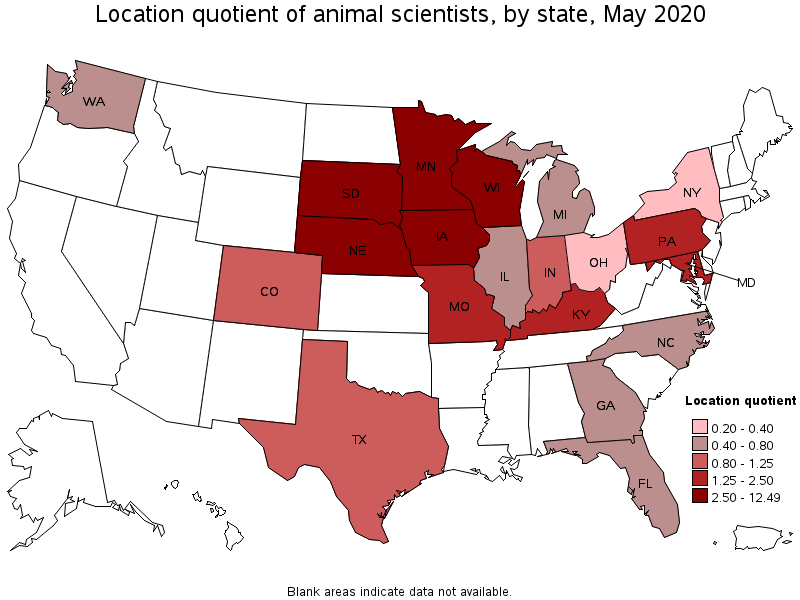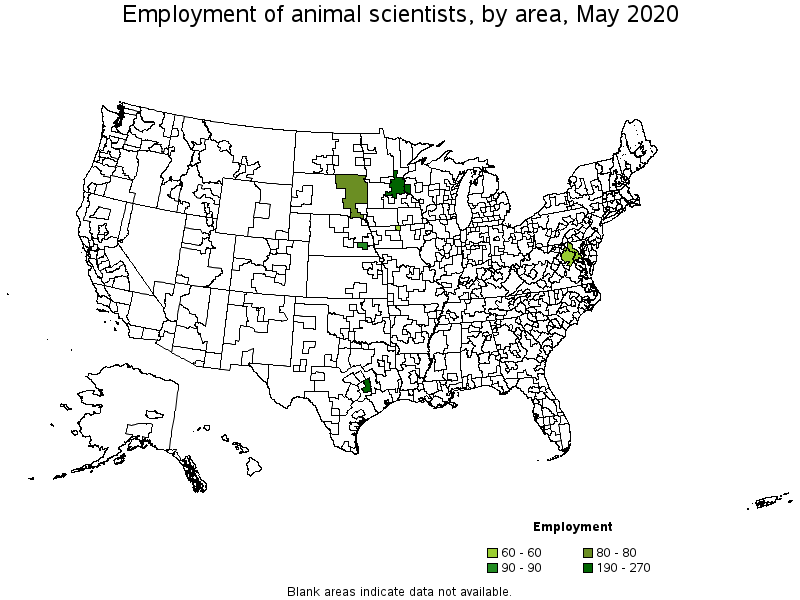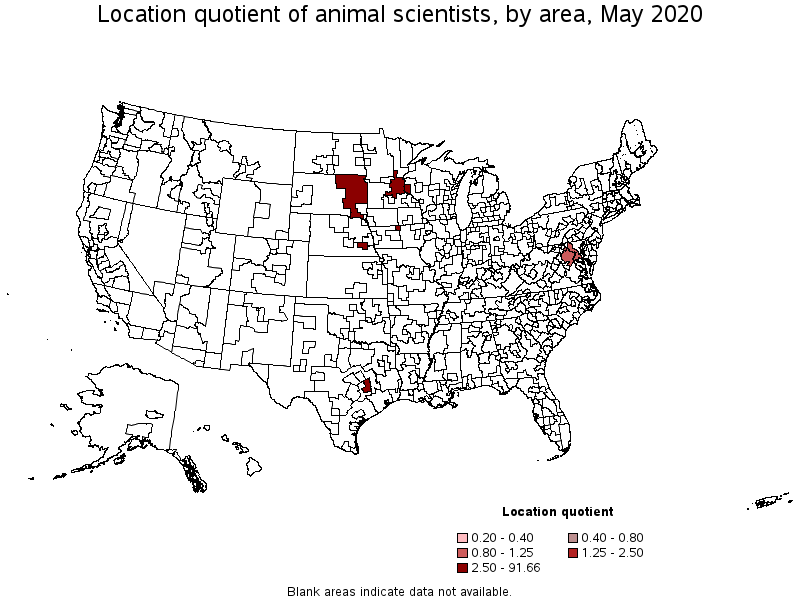An official website of the United States government
 United States Department of Labor
United States Department of Labor
Conduct research in the genetics, nutrition, reproduction, growth, and development of domestic farm animals.
Employment estimate and mean wage estimates for Animal Scientists:
| Employment (1) | Employment RSE (3) |
Mean hourly wage |
Mean annual wage (2) |
Wage RSE (3) |
|---|---|---|---|---|
| 2,680 | 7.3 % | $ 35.84 | $ 74,540 | 2.3 % |
Percentile wage estimates for Animal Scientists:
| Percentile | 10% | 25% | 50% (Median) |
75% | 90% |
|---|---|---|---|---|---|
| Hourly Wage | $ 19.58 | $ 24.16 | $ 30.52 | $ 41.87 | $ 60.21 |
| Annual Wage (2) | $ 40,720 | $ 50,260 | $ 63,490 | $ 87,080 | $ 125,250 |
Industries with the highest published employment and wages for Animal Scientists are provided. For a list of all industries with employment in Animal Scientists, see the Create Customized Tables function.
Industries with the highest levels of employment in Animal Scientists:
| Industry | Employment (1) | Percent of industry employment | Hourly mean wage | Annual mean wage (2) |
|---|---|---|---|---|
| Colleges, Universities, and Professional Schools | 760 | 0.02 | $ 26.85 | $ 55,840 |
| Scientific Research and Development Services | 620 | 0.08 | $ 38.09 | $ 79,220 |
| Support Activities for Animal Production | 240 | 0.76 | (8) | (8) |
| Animal Food Manufacturing | 240 | 0.37 | $ 37.12 | $ 77,200 |
| Pharmaceutical and Medicine Manufacturing | 180 | 0.06 | $ 41.62 | $ 86,580 |
Industries with the highest concentration of employment in Animal Scientists:
| Industry | Employment (1) | Percent of industry employment | Hourly mean wage | Annual mean wage (2) |
|---|---|---|---|---|
| Support Activities for Animal Production | 240 | 0.76 | (8) | (8) |
| Animal Food Manufacturing | 240 | 0.37 | $ 37.12 | $ 77,200 |
| Scientific Research and Development Services | 620 | 0.08 | $ 38.09 | $ 79,220 |
| Pharmaceutical and Medicine Manufacturing | 180 | 0.06 | $ 41.62 | $ 86,580 |
| Merchant Wholesalers, Nondurable Goods (4241, 4247, and 4249 only) | 170 | 0.03 | $ 39.60 | $ 82,370 |
Top paying industries for Animal Scientists:
| Industry | Employment (1) | Percent of industry employment | Hourly mean wage | Annual mean wage (2) |
|---|---|---|---|---|
| Federal Executive Branch (OEWS Designation) | 80 | (7) | $ 57.37 | $ 119,340 |
| Management, Scientific, and Technical Consulting Services | 80 | 0.01 | $ 46.99 | $ 97,740 |
| Management of Companies and Enterprises | 40 | (7) | $ 44.95 | $ 93,490 |
| Pharmaceutical and Medicine Manufacturing | 180 | 0.06 | $ 41.62 | $ 86,580 |
| Merchant Wholesalers, Nondurable Goods (4241, 4247, and 4249 only) | 170 | 0.03 | $ 39.60 | $ 82,370 |
States and areas with the highest published employment, location quotients, and wages for Animal Scientists are provided. For a list of all areas with employment in Animal Scientists, see the Create Customized Tables function.

States with the highest employment level in Animal Scientists:
| State | Employment (1) | Employment per thousand jobs | Location quotient (9) | Hourly mean wage | Annual mean wage (2) |
|---|---|---|---|---|---|
| Minnesota | 350 | 0.13 | 6.64 | $ 33.85 | $ 70,410 |
| Texas | 290 | 0.02 | 1.23 | $ 26.54 | $ 55,190 |
| Wisconsin | 250 | 0.09 | 4.83 | $ 40.73 | $ 84,710 |
| Pennsylvania | 190 | 0.03 | 1.75 | $ 31.72 | $ 65,980 |
| Iowa | 130 | 0.09 | 4.75 | $ 32.59 | $ 67,780 |

States with the highest concentration of jobs and location quotients in Animal Scientists:
| State | Employment (1) | Employment per thousand jobs | Location quotient (9) | Hourly mean wage | Annual mean wage (2) |
|---|---|---|---|---|---|
| South Dakota | 100 | 0.24 | 12.49 | $ 26.48 | $ 55,070 |
| Minnesota | 350 | 0.13 | 6.64 | $ 33.85 | $ 70,410 |
| Nebraska | 110 | 0.11 | 5.82 | $ 32.03 | $ 66,630 |
| Wisconsin | 250 | 0.09 | 4.83 | $ 40.73 | $ 84,710 |
| Iowa | 130 | 0.09 | 4.75 | $ 32.59 | $ 67,780 |

Top paying states for Animal Scientists:
| State | Employment (1) | Employment per thousand jobs | Location quotient (9) | Hourly mean wage | Annual mean wage (2) |
|---|---|---|---|---|---|
| California | (8) | (8) | (8) | $ 55.53 | $ 115,510 |
| North Carolina | 40 | 0.01 | 0.51 | $ 49.14 | $ 102,210 |
| Missouri | 100 | 0.04 | 1.95 | $ 44.23 | $ 92,000 |
| Maryland | 100 | 0.04 | 1.98 | $ 43.77 | $ 91,040 |
| Wisconsin | 250 | 0.09 | 4.83 | $ 40.73 | $ 84,710 |

Metropolitan areas with the highest employment level in Animal Scientists:
| Metropolitan area | Employment (1) | Employment per thousand jobs | Location quotient (9) | Hourly mean wage | Annual mean wage (2) |
|---|---|---|---|---|---|
| Minneapolis-St. Paul-Bloomington, MN-WI | 270 | 0.15 | 7.62 | $ 31.33 | $ 65,160 |
| College Station-Bryan, TX | 190 | 1.76 | 91.66 | $ 23.00 | $ 47,830 |
| Lincoln, NE | 90 | 0.49 | 25.64 | $ 25.07 | $ 52,140 |
| Ames, IA | 60 | 1.41 | 73.38 | $ 33.27 | $ 69,200 |
| Washington-Arlington-Alexandria, DC-VA-MD-WV | 60 | 0.02 | 1.01 | $ 53.15 | $ 110,540 |

Metropolitan areas with the highest concentration of jobs and location quotients in Animal Scientists:
| Metropolitan area | Employment (1) | Employment per thousand jobs | Location quotient (9) | Hourly mean wage | Annual mean wage (2) |
|---|---|---|---|---|---|
| College Station-Bryan, TX | 190 | 1.76 | 91.66 | $ 23.00 | $ 47,830 |
| Ames, IA | 60 | 1.41 | 73.38 | $ 33.27 | $ 69,200 |
| Lincoln, NE | 90 | 0.49 | 25.64 | $ 25.07 | $ 52,140 |
| Minneapolis-St. Paul-Bloomington, MN-WI | 270 | 0.15 | 7.62 | $ 31.33 | $ 65,160 |
| Washington-Arlington-Alexandria, DC-VA-MD-WV | 60 | 0.02 | 1.01 | $ 53.15 | $ 110,540 |

Top paying metropolitan areas for Animal Scientists:
| Metropolitan area | Employment (1) | Employment per thousand jobs | Location quotient (9) | Hourly mean wage | Annual mean wage (2) |
|---|---|---|---|---|---|
| Washington-Arlington-Alexandria, DC-VA-MD-WV | 60 | 0.02 | 1.01 | $ 53.15 | $ 110,540 |
| Ames, IA | 60 | 1.41 | 73.38 | $ 33.27 | $ 69,200 |
| Minneapolis-St. Paul-Bloomington, MN-WI | 270 | 0.15 | 7.62 | $ 31.33 | $ 65,160 |
| Lincoln, NE | 90 | 0.49 | 25.64 | $ 25.07 | $ 52,140 |
| College Station-Bryan, TX | 190 | 1.76 | 91.66 | $ 23.00 | $ 47,830 |
Nonmetropolitan areas with the highest employment in Animal Scientists:
| Nonmetropolitan area | Employment (1) | Employment per thousand jobs | Location quotient (9) | Hourly mean wage | Annual mean wage (2) |
|---|---|---|---|---|---|
| East South Dakota nonmetropolitan area | 80 | 0.61 | 31.96 | $ 25.09 | $ 52,190 |
Nonmetropolitan areas with the highest concentration of jobs and location quotients in Animal Scientists:
| Nonmetropolitan area | Employment (1) | Employment per thousand jobs | Location quotient (9) | Hourly mean wage | Annual mean wage (2) |
|---|---|---|---|---|---|
| East South Dakota nonmetropolitan area | 80 | 0.61 | 31.96 | $ 25.09 | $ 52,190 |
Top paying nonmetropolitan areas for Animal Scientists:
| Nonmetropolitan area | Employment (1) | Employment per thousand jobs | Location quotient (9) | Hourly mean wage | Annual mean wage (2) |
|---|---|---|---|---|---|
| Southwest Minnesota nonmetropolitan area | (8) | (8) | (8) | $ 40.24 | $ 83,700 |
| Western Wisconsin nonmetropolitan area | (8) | (8) | (8) | $ 38.81 | $ 80,720 |
| Kansas nonmetropolitan area | (8) | (8) | (8) | $ 38.43 | $ 79,930 |
| East South Dakota nonmetropolitan area | 80 | 0.61 | 31.96 | $ 25.09 | $ 52,190 |
These estimates are calculated with data collected from employers in all industry sectors, all metropolitan and nonmetropolitan areas, and all states and the District of Columbia. The top employment and wage figures are provided above. The complete list is available in the downloadable XLS files.
The percentile wage estimate is the value of a wage below which a certain percent of workers fall. The median wage is the 50th percentile wage estimate—50 percent of workers earn less than the median and 50 percent of workers earn more than the median. More about percentile wages.
(1) Estimates for detailed occupations do not sum to the totals because the totals include occupations not shown separately. Estimates do not include self-employed workers.
(2) Annual wages have been calculated by multiplying the hourly mean wage by a "year-round, full-time" hours figure of 2,080 hours; for those occupations where there is not an hourly wage published, the annual wage has been directly calculated from the reported survey data.
(3) The relative standard error (RSE) is a measure of the reliability of a survey statistic. The smaller the relative standard error, the more precise the estimate.
(7) The value is less than .005 percent of industry employment.
(8) Estimate not released.
(9) The location quotient is the ratio of the area concentration of occupational employment to the national average concentration. A location quotient greater than one indicates the occupation has a higher share of employment than average, and a location quotient less than one indicates the occupation is less prevalent in the area than average.
Other OEWS estimates and related information:
May 2020 National Occupational Employment and Wage Estimates
May 2020 State Occupational Employment and Wage Estimates
May 2020 Metropolitan and Nonmetropolitan Area Occupational Employment and Wage Estimates
May 2020 National Industry-Specific Occupational Employment and Wage Estimates
Last Modified Date: March 31, 2021